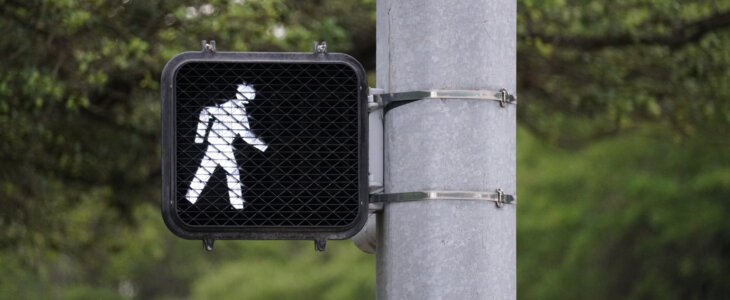Pedestrian right-of-way laws protect both pedestrians and vehicle occupants. They outline who has the right of way under different circumstances and can help determine who’s at fault in the event of a vehicle-vs.-pedestrian accident. Is it the driver, the pedestrian, or both?
California Pedestrian Right-of-Way Laws
California Vehicle Code Sections 21950-21954 cover pedestrian right-of-way laws. Pedestrians have the right-of-way when crossing a road at a marked or unmarked crosswalk and in certain other circumstances. However, the laws do not relieve pedestrians of the duty to exhibit caution.
Key Right-of-Way Law Components
The following are four key components of California’s pedestrian right-of-way laws:
- Marked Crosswalks – Pedestrians have the right-of-way when crossing in marked crosswalks at intersections. Drivers must stop and yield to pedestrians crossing in this way.
- Unmarked Crosswalks – Not all intersections have marked crosswalks. However, pedestrians crossing at these intersections still have the right-of-way. Drivers should treat such intersections as if they have a crosswalk.
- Mid-Block Crossings – In most cases, pedestrians crossing a road in the middle of a block (meaning not at an intersection or marked crosswalk) still have the right-of-way. However, they cannot suddenly enter the roadway close to a vehicle. If the vehicle doesn’t have enough time to stop safely, the driver has the right-of-way.
- Pedestrian Due Care – When crossing a road, pedestrians must exercise due care. They should be mindful of their safety and not unnecessarily stop or delay traffic. Obeying traffic signals and looking both ways before crossing are examples of due care.
Determining Fault in Pedestrian Accidents
Determining who’s at fault in a pedestrian accident requires a holistic look at the situation. Did either party violate traffic laws? Did they disregard safety and act negligently? Here are the three most common pedestrian accident scenarios:
- Driver’s Fault – A driver may be at fault if they fail to yield to a pedestrian in a crosswalk. If the driver was speeding, distracted, or not following the rules of the road, that will make it easier to prove their fault.
- Pedestrian’s Fault – A pedestrian may be at fault if they fail to exercise caution when crossing a road. Ignoring traffic signals or running out into traffic could give the driver little time to react.
- Comparative Fault – California is a comparative fault state. That means courts will apportion fault between everyone involved in an accident based on their actions. If both parties contributed to the accident, they could each be partially liable.
Let’s use an example to illustrate comparative fault. Imagine a driver and a pedestrian looking at their phones. The pedestrian doesn’t check for traffic before crossing the street, and the driver doesn’t look up to see the pedestrian crossing. A court would need to review the specific facts of the case to come to a decision about fault.
Preventive Measures and Safety Tips
The most important thing for pedestrians is to always look both ways before crossing a road. If a car is approaching, make eye contact with the driver before you enter the roadway. That way, you can confirm that they’ve seen you.
The most important thing for drivers is to stay vigilant. Be on the lookout for pedestrians who may be entering the roadway from between parked cars. Never use your phone or other devices while driving.
Contact Our Walnut Creek Pedestrian Accident Lawyer
If you’ve been injured in a vehicle-pedestrian accident in Walnut Creek, an experienced personal injury attorney can help you seek the compensation you deserve for your medical bills, lost income, pain and suffering, and more. At Casper, Meadows, Schwartz, & Cook, we can investigate your case to determine whether the driver was at fault and, if so, how much they owe you. Contact our Walnut Creek law office today for a free consultation with our pedestrian accident lawyers.

